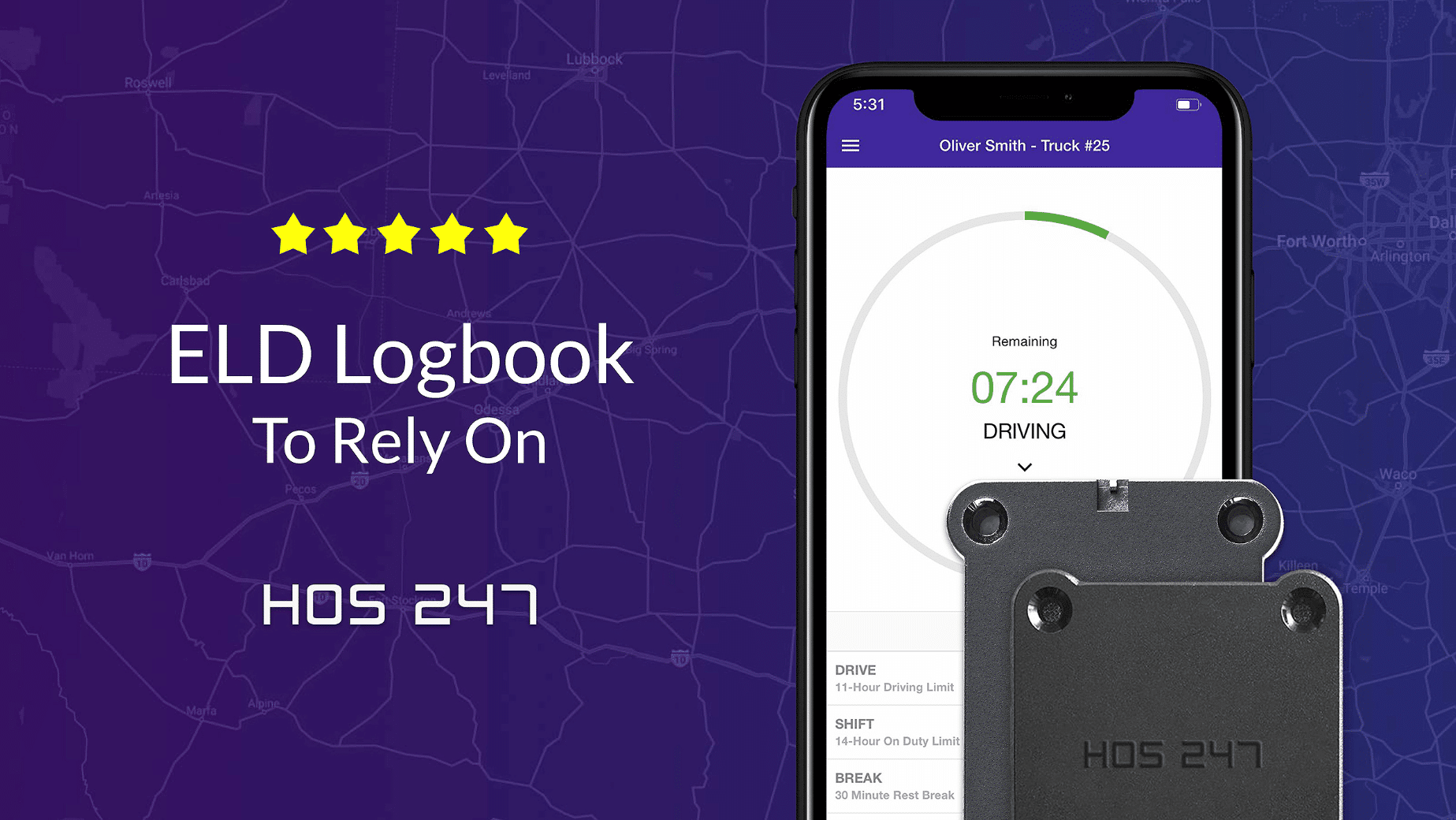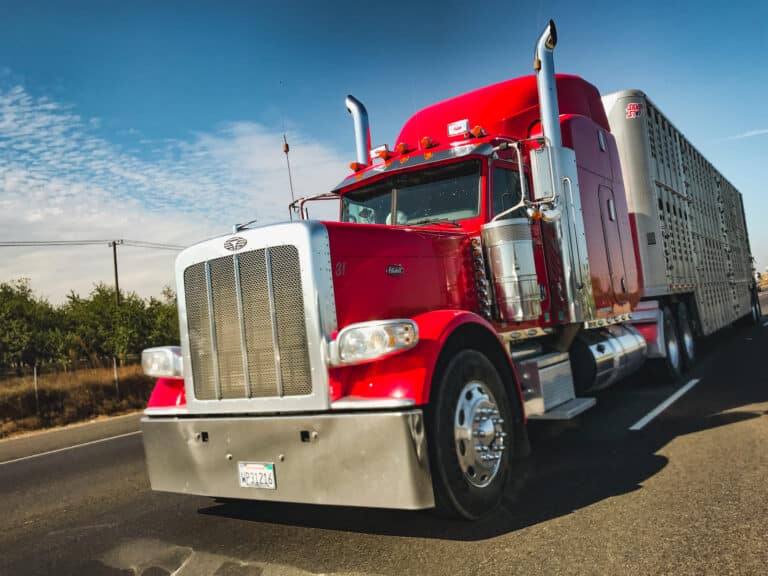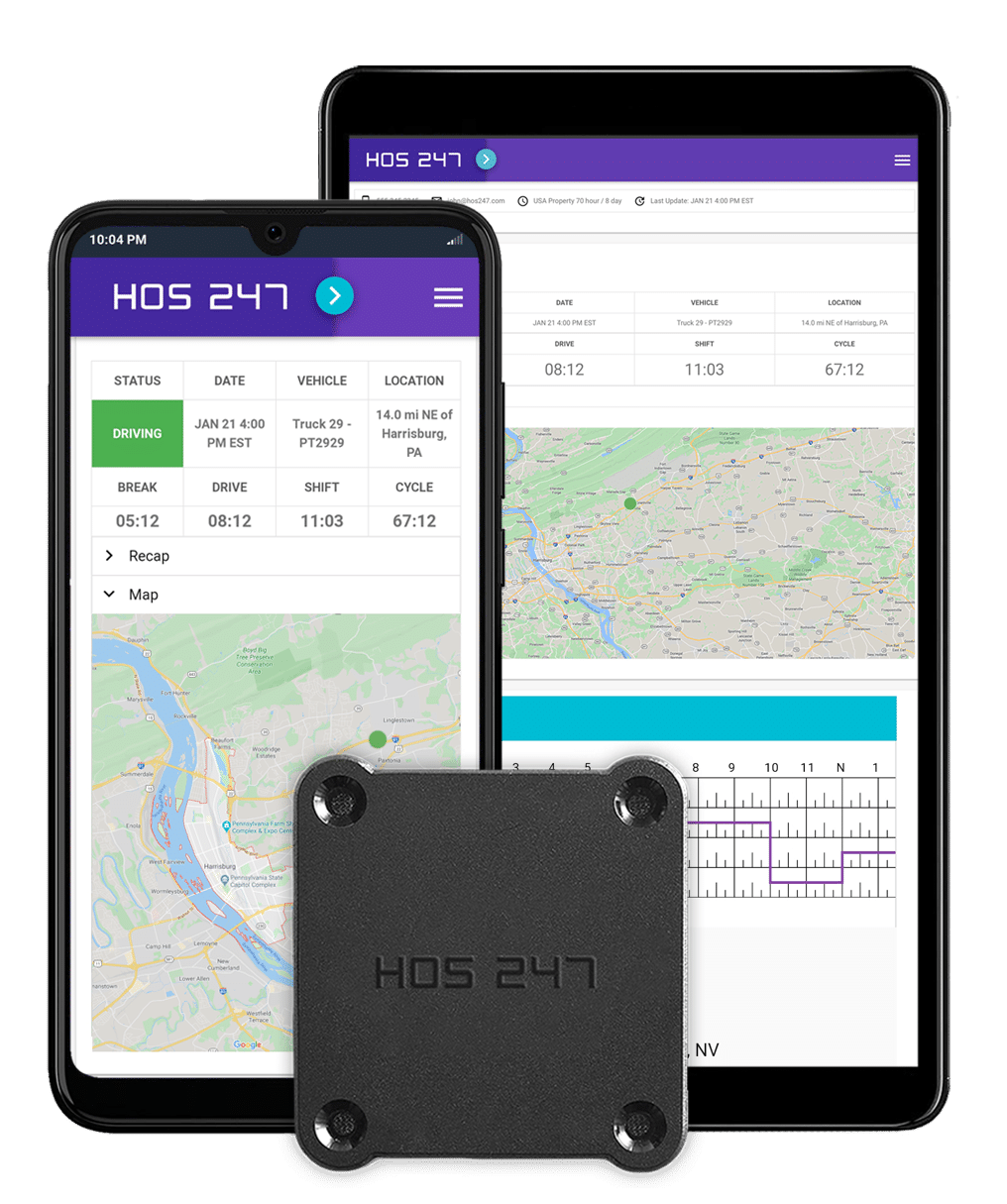Understanding Commercial Hours of Service Regulations: A Trucker’s Guide to ELD Compliance
Commercial hours of service (HOS) regulations control how long you can drive, when you must take breaks, and how much rest time you need between shifts. These federal rules aren’t just bureaucratic red tape — they’re designed to prevent driver fatigue, which causes thousands of commercial vehicle accidents each year.
Since the ELD mandate took effect, staying compliant depends heavily on the quality of your electronic logging device. A reliable electronic logbook helps you track hours accurately and avoid violations. A poor-quality device can lead to data loss, compliance problems, and potential threats to your commercial drivers licence (CDL).
This guide covers the essential HOS rules for both freight and passenger operations, common violations to avoid, and why elog quality matters for compliance and operational success. Whether you’re buying your first ELD or switching providers, you’ll learn how to choose a device that supports rather than complicates your compliance efforts.
Do you have any questions? Talk to ELD Advisor: 650-405-3372 or Request Callback
What Are Commercial Hours of Service Regulations?
Commercial hours of service regulations are federal rules established by the Federal Motor Carrier Safety Administration (FMCSA) that limit driving time for commercial drivers before mandatory rest periods. These regulations combat driver fatigue, a leading factor in commercial vehicle crashes involving serious injuries and fatalities.

Who Must Comply with HOS Regulations
Understanding whether HOS regulations apply to your operation is the first step toward compliance. HOS regulations apply to drivers of commercial motor vehicles (CMVs). The FMCSA defines a CMV as any vehicle meeting one or more of these criteria:
Weight Thresholds:
- Gross vehicle weight rating (GVWR) or gross combination weight rating (GCWR) of 26,001 pounds or more.
- GVWR, gross vehicle weight (GVW), GCWR, or gross combination weight (GCW) of 10,001 pounds or more.
Passenger Capacity:
- Designed or used to transport 16 or more passengers, including the driver (interstate commerce).
- Designed or used to transport 9 or more passengers for compensation (interstate commerce).
Hazardous Materials:
- Transports hazardous materials requiring DOT placards.
Interstate vs. Intrastate Commerce Distinctions
Different HOS rules apply depending on the scope of your operations:
Interstate commerce involves transportation crossing state lines or affecting interstate commerce. This includes driving between states and intrastate trips that are part of interstate journeys. These drivers follow federal HOS regulations.
Intrastate commerce involves transportation beginning and ending within the same state without affecting interstate commerce. While many intrastate drivers still follow federal HOS rules, some states have different intrastate requirements.
Special Situations and Exceptions
The FMCSA recognizes certain situations requiring flexibility:
- Short-haul operations. Drivers operating within 150 air-miles (100 air-miles for non-CDL vehicles) who return to their starting point within 12 hours may qualify for HOS exemptions.
- Emergency conditions. During declared emergencies, drivers may receive temporary HOS relief to provide essential services.
- Agricultural operations. Modified HOS requirements may apply during planting and harvest seasons.
- Oil and gas operations. Special HOS rules may apply for drivers supporting energy field operations.
Historical Context and Safety Purpose
HOS regulations evolved from decades of research linking driver fatigue to crash risk. The transportation industry and safety researchers have long recognized that exhausted drivers experience slower reaction times, impaired judgment, and reduced alertness — all factors that significantly increase accident risk.
Before comprehensive HOS rules, drivers often worked excessive hours with minimal rest. Competitive pressures made voluntary rest standards difficult to maintain industry-wide. Federal regulations created uniform safety standards, ensuring no company gains advantage by compromising driver safety.
HOS regulations protect drivers and the public by:
- Limiting consecutive driving time to prevent acute fatigue.
- Requiring regular breaks to maintain alertness.
- Mandating sufficient off-duty time for adequate sleep.
- Restricting weekly driving hours to prevent cumulative fatigue.
- Providing restart provisions to reset weekly limits.
Understanding these regulations is fundamental, but compliance depends on accurate tracking and documentation. This is where your ELD’s reliability becomes crucial for maintaining compliance and protecting your livelihood.

Property vs Passenger Carrying Rules
Commercial drivers must follow different HOS regulations depending on whether they transport property (freight, goods, materials) or passengers. Understanding which rules apply to your operation is essential for compliance and avoiding violations.
Property-Carrying Commercial Vehicle Rules
Most freight drivers operate under property-carrying HOS regulations, which include these key requirements:
- 11-hour driving limit. You can drive a maximum of 11 hours after 10 consecutive hours off duty.
- 14-hour duty period. You cannot drive beyond the 14th consecutive hour after coming on duty, regardless of how much driving time you’ve used. This window includes all on-duty time.
- 30-minute break requirement. You must take a break of at least 30 minutes before driving after being on duty for 8 cumulative hours.
- 60/70-hour limits. You cannot drive after being on duty for 60 hours in 7 consecutive days or 70 hours in 8 consecutive days.
- 34-hour restart. You can restart your 60/70-hour clock by taking at least 34 consecutive hours off duty.
Passenger-Carrying Commercial Vehicle Rules
Drivers of buses, shuttles, and other passenger-carrying vehicles follow different regulations:
- 10-hour driving limit. Passenger-carrying drivers can drive a maximum of 10 hours after 8 consecutive hours off duty.
- 15-hour duty period. You cannot drive beyond the 15th consecutive hour after coming on duty.
- No 30-minute break requirement. Unlike property drivers, passenger-carrying drivers don’t have a mandatory 30-minute break requirement.
- 60/70-hour limits. The same weekly limits apply as property drivers.
- 34-hour restart. Passenger drivers can also use the 34-hour restart provision.
Your ELD must be properly configured for your operation type because the device calculates available hours differently and provides appropriate violation warnings for each rule set.
Common HOS Violations and How to Avoid Them
Understanding frequent HOS violations helps you recognize potential problems before they result in fines or out-of-service orders. Most violations are preventable with proper planning and reliable ELD equipment. Most frequent HOS violations include:
Driving Beyond 11-Hour/10-Hour Limits
This violation occurs when drivers exceed maximum allowed driving time. It’s often caused by poor trip planning, unexpected delays, or ELD malfunctions.
Prevention Strategies:
- Plan routes with buffer time for delays.
- Monitor available driving hours throughout the day.
- Use an ELD that provides clear, real-time hour calculations.
- Set personal alerts before reaching maximum driving time.
14-Hour/15-Hour Rule Violations
Exceeding the duty period window is common when drivers underestimate loading, unloading, or waiting times.
Prevention Strategies:
- Factor realistic loading times into trip planning.
- Communicate delays with dispatch immediately.
- Understand that the duty clock runs continuously once you go on duty.
- Plan shorter driving days when extended loading is expected.
Missing 30-Minute Breaks
Property-carrying drivers must take a 30-minute break after 8 cumulative hours of driving. A driver can be on duty for 10 hours (without driving) and not yet need a break.
Prevention Strategies:
- Set reminders for break requirements.
- Ensure your ELD accurately tracks break compliance.
- Take breaks slightly longer than 30 minutes to account for timing variations.
Weekly Limit Violations
Exceeding 60/70-hour weekly limits often happens when drivers lose track of accumulated hours.
Prevention Strategies:
- Regularly review weekly hour totals.
- Plan restart periods in advance.
- Use ELD reports to track weekly hour trends.
ELD Malfunctions Leading to Compliance Issues
While driver error causes many HOS violations, equipment failures can also put you at risk of compliance problems. These are some common elog problems drivers should recognize before they become serious compliance risks:
- Data synchronization problems. When your ELD fails to properly sync between hardware and mobile app, you may lose driving time data or have incomplete logs.
- Connectivity failures. Poor cellular coverage or device connectivity issues can result in gaps in electronic logs.
- Incorrect hour calculations. Some electronic logbooks miscalculate available hours, especially with complex scheduling scenarios.
- Hardware reliability issues. Frequent device failures or hardware malfunctions can compromise your ability to maintain compliant logs.
The quality and reliability of your ELD directly impacts your ability to avoid these violations. A well-designed, thoroughly tested device with responsive customer support can prevent costly compliance problems.

Electronic Logging Compliance Checklist
Understanding the mandate’s requirements and inspection procedures helps you stay compliant and avoid problems during roadside checks.
Your ELD Must:
- Be self-certified by the manufacturer and registered with FMCSA.
- Connect to your vehicle’s engine control module to capture data automatically.
- Automatically record driving time when the vehicle moves above 5 mph.
- Transfer data to enforcement officers during roadside inspections.
- Be tamper-resistant and secure from unauthorized modifications.
Driver Responsibilities:
- Check that your ELD records are accurate.
- Add notes for duty status changes the device doesn’t record automatically.
- Sign off on your logs at the end of each day.
- Keep your RODS for the current day and the previous 7 consecutive days.
- Transfer your hours-of-service records to authorized safety officials upon request using the instruction sheet provided by your carrier.
- Report ELD malfunctions to your motor carrier within 24 hours and maintain paper logs during malfunctions.
Motor Carrier Requirements:
- Provide drivers with an ELD information packet including user manual, data transfer instructions, malfunction reporting procedures, and at least 8 days of blank paper logs.
- Keep elog records and backup data for 6 months on separate devices.
- Ensure no one tampers with the device or alters original hours-of-service data.
- Repair, replace, or service malfunctioning ELDs within 8 days of discovery.
Following these minimum requirements ensures compliance with federal ELD regulations under 49 CFR Part 395, Subpart B.
Why ELD Quality Matters for HOS Compliance
The connection between ELD quality and staying compliant goes beyond basic functions. Your electronic logging device is your main record for following federal HOS rules, making its reliability and accuracy critical for protecting your CDL and career. The switch to electronic logs made ELD reliability more important than ever. Your device isn’t just a tool — it’s your main protection against HOS violations. Poor-quality ELDs create compliance risks through wrong hour calculations, lost data, connection problems, and hardware failures that force you back to paper logs.
How Device Reliability Affects Compliance
A quality ELD automatically captures driving time, location data, and vehicle movement accurately. Wrong information can create compliance gaps that officers see as violations, even when you followed all HOS rules correctly. Your electronic logbook must also calculate available driving time, duty periods, and required breaks correctly across different situations including sleeper berth splits and complex schedules.
Staying compliant depends on producing accurate logs during inspections. Quality devices keep complete, correct data that enforcement officers can easily access and check. Good electronic logbooks also give you timely warnings before you reach HOS limits, helping you make smart decisions about routes and rest periods.
Real Consequences of Compliance Problems
HOS violations carry heavy fines ranging from hundreds to thousands of dollars per violation. Serious violations can result in immediate out-of-service orders that prevent you from driving until you fix compliance problems. This means lost money and potentially damaged customer relationships.
Violations also hurt your CSA scores, which affect insurance rates, job opportunities, and carrier relationships. Poor scores can limit your career options and earning potential. Repeated or serious HOS violations can threaten your Commercial Driver’s License through state actions or carrier policies.
What to Look for in Quality ELDs
When choosing an ELD, focus on key features that directly impact your compliance success and daily operations.
- Hardware reliability includes steady power that prevents unexpected shutdowns, tough construction that handles truck vibrations and temperature changes, and secure mounting that keeps connections stable.
- Software performance means accurate HOS rule implementation that reflects current regulations, easy-to-use interfaces that prevent mistakes, and regular updates that address regulation changes and fix problems.
- Connection stability involves reliable cellular connections across different coverage areas, effective data storage when connections drop, and quick reconnection when coverage returns.
- Customer support quality means knowledgeable technical support available when you need help, quick response times when compliance issues come up, and complete training resources.
The quality of your ELD directly affects your ability to stay compliant in today’s digital environment. Investing in reliable equipment with proven performance protects both your current operations and your long-term career in trucking.
HOS247 ELD: Reliable Solution for Hours of Service Compliance
HOS247 ELD is built for drivers who need dependable compliance tools that work when it matters most. Our system combines reliable hardware, easy-to-use software, and responsive customer support to keep you compliant without the headaches that come with poor-quality devices. Key benefits include:
- Proven reliability. HOS247 ELD is rigorously tested to meet all FMCSA requirements. The device consistently performs in real-world conditions, giving you accurate data you can trust during inspections and daily operations.
- User-friendly interface. The intuitive design reduces mistakes and makes logging simple. You spend less time figuring out your electronic logbook and more time driving safely and efficiently.
- Stable connectivity. HOS247 maintains reliable connections even in areas with poor cell coverage. The system stores data when connectivity drops and syncs everything when connection returns, preventing gaps in your logs.
- No long-term contracts. Month-to-month plans mean you stay with HOS247 because it works, not because you’re locked in. This flexibility shows our confidence in the product quality.
- Multilingual support. Available in English, Spanish, Russian, and Polish with customer support every day of the week. Our callback policy ensures if a call drops, we call you back immediately.
- Automatic updates. Software automatically updates to stay current with FMCSA regulations. You never have to worry about outdated software causing compliance problems.
Additional Features That Matter
- Two-week risk-free trial. Test the system before you commit. This trial period lets you verify that HOS247 meets your needs without risk.
- IFTA calculations. Automatic mileage tracking by state reduces paperwork and ensures accurate fuel tax reporting.
- Real-time GPS tracking. Know where your vehicles are and maintain detailed location records for compliance and operational purposes.
- One-year hardware warranty. We stand behind our equipment quality with comprehensive warranty protection.
How HOS247 Solves Common ELD Problems
Many drivers face issues with ELDs that lose data, calculate hours wrong, or offer poor customer support when problems happen. HOS247 fixes these problems directly.
Our system prevents data loss through reliable connectivity technology. Hour calculations stay accurate in all situations, including sleeper berth splits and crossing state lines. When you need help, you talk to knowledgeable support staff who understand trucking, not automated systems that waste your time.
HOS247 works consistently even in remote areas where other devices fail. The system keeps your compliance records safe during connection problems and updates everything quickly when coverage returns.

Conclusion
Staying compliant with commercial hours of service regulations requires more than knowing the rules — you need reliable tools that work consistently. The quality of your ELD directly affects your ability to maintain compliance and protect your career.
Quality ELDs prevent compliance problems before they start. Accurate hour tracking, reliable data storage, stable connections, and responsive support help you avoid violations that can cost hundreds or thousands of dollars. Poor-quality devices create unnecessary risks through data loss, connectivity failures, and inadequate customer support.
When choosing an ELD, focus on proven reliability, ease of use, stable connectivity, and quality customer support. Don’t risk your livelihood with unreliable equipment. Try HOS247 and experience the difference that quality makes in your daily operations.
A Note to Our Readers on Compliance
This article is intended for informational and educational purposes only. It is not a substitute for official regulatory guidance or legal advice. HOS and ELD regulations are complex and subject to change and interpretation by enforcement officials. Please always refer to official sources for the most current and accurate information.

As an expert in B2B and B2C sales, I’ve dedicated myself to perfecting sales processes and client retention strategies in the logistics and trucking industry. I have significantly contributed to the expansion of the ELD service, catering to retail and wholesale clients in need of HOS247 ELD solutions. My unwavering commitment to implementing state-of-the-art sales techniques and technologies ensures the continuous growth and success of businesses I work with.












Commercial drivers are legally required to use electronic logging devices and apps to record their hours of service (HOS). With over 800 systems available, choosing an electronic logbook can be a daunting process. While compliance is crucial, there are several

If you’re a long haul driver in the United States, you’re likely subject to the ELD mandate. This rule, set by the Federal Motor Carrier Safety Administration (FMCSA), requires most commercial drivers to use electronic logging devices (ELDs) to track

With the advancement of technology, commercial trailer tracking systems have emerged as powerful tools, enabling motor carriers to optimize their processes and achieve remarkable efficiency and security. By implementing fleet management GPS tracking, businesses can unlock a wide range of
